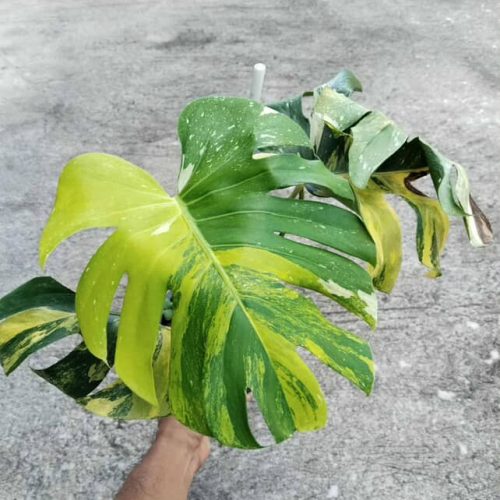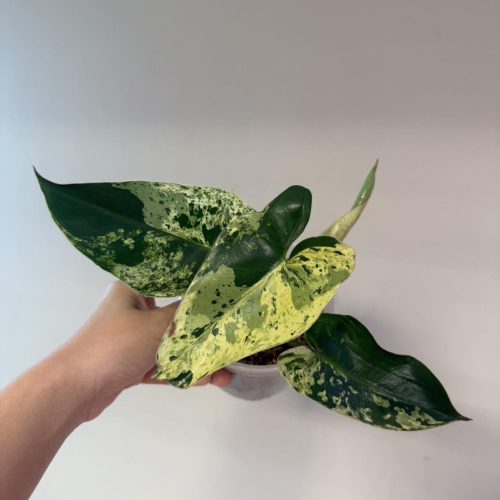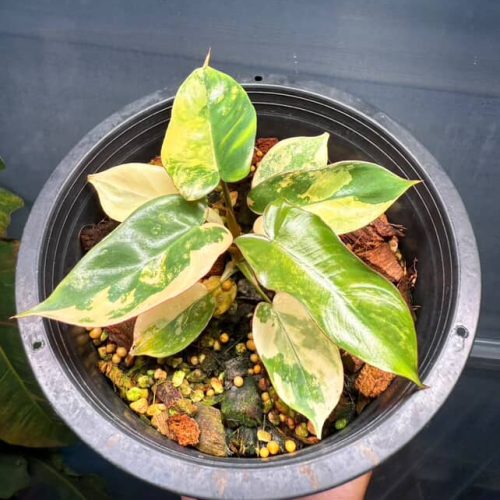Introduction to Philodendron Pedatum Glad Hands
Philodendron Pedatum Glad Hands, also known simply as “Glad Hands,” is a unique and fascinating variety of the Philodendron Pedatum species. Its intriguing appearance, ease of care, and adaptability make it a popular choice among houseplant enthusiasts. In this comprehensive guide, we’ll explore the characteristics of this beautiful plant, learn how to grow and maintain it, and delve into propagation methods.

Characteristics of Philodendron Pedatum Glad Hands
Leaves
One of the most striking features of the Philodendron Pedatum Glad Hands is its leaves. The large, lobed leaves have a distinct, hand-like shape with elongated, finger-like projections. As the plant matures, the leaves can develop an attractive, deep green hue with a glossy finish. To learn more about the physical characteristics of different Philodendron species, including their foliage, you can refer to our extensive guide
Stems
The stems of Glad Hands are slender and flexible, with a reddish-brown coloration that adds a touch of contrast against the vibrant foliage. They tend to grow in a climbing or trailing manner, making the plant an excellent candidate for hanging baskets or climbing support structures.
Growth Habit
Philodendron Pedatum Glad Hands has a moderate growth rate, and with proper care, it can reach lengths of up to 6 feet (1.8 meters) or more. Its climbing habit makes it a great choice for vertical gardens, trellises, or other support structures.
Roots
The roots of this Philodendron are relatively shallow and can be sensitive to overwatering. They require a well-draining soil to prevent root rot and promote healthy growth.
Growing Philodendron Pedatum Glad Hands
Light Requirements
Glad Hands prefers bright, indirect light but can also tolerate lower light conditions. Direct sunlight should be avoided, as it can cause the leaves to become scorched and lose their vibrant color. Glad Hands prefers bright, indirect light but can also tolerate lower light conditions. For detailed information on the best lighting conditions for your Philodendron, check out our in-depth guide
Watering
To maintain proper moisture levels, water your Glad Hands when the top 1-2 inches (2.5-5 cm) of soil feel dry to the touch. Be careful not to overwater, as this can lead to root rot and other issues.
Soil
A well-draining, peat-based potting mix is ideal for Philodendron Pedatum Glad Hands. You can create your own mix by combining equal parts peat moss, perlite, and orchid bark. Similar mixtures are beneficial for plants like Homalomena and Colocasia.
Temperature and Humidity
Glad Hands thrive in temperatures ranging from 65-80°F (18-27°C) and prefer moderate to high humidity levels. To increase humidity, consider placing a humidifier nearby or grouping your plant with other moisture-loving plants. Syngonium and Epipremnum also appreciate similar humidity conditions.
Fertilization
Feed your Philodendron Pedatum Glad Hands with a balanced liquid fertilizer diluted to half-strength every 4-6 weeks during the growing season. Reduce the frequency to once every 8 weeks during the cooler months. Over-fertilization can cause leaf burn, so always follow the manufacturer’s instructions.

“Unlock the beauty of nature in your home with the Philodendron Pedatum Glad Hands! Click here to bring this exotic elegance to your space today.”
Philodendron species are the most sought after by aroid plant lovers
Propagating Philodendron Pedatum Glad Hands
Stem Cuttings
One of the easiest ways to propagate Glad Hands is through stem cuttings. Simply cut a healthy stem with at least one leaf and a few aerial roots. Allow the cutting to air dry for a few hours before placing it in a jar of water or a well-draining potting mix. Keep the cutting in a warm, bright location and monitor the root development.
Air Layering
Air layering is another effective method for propagating Philodendron Pedatum Glad Hands. To do this, choose a healthy stem with aerial roots and make a small incision. Wrap the incision in moist sphagnum moss, and then cover it with plastic wrap. Secure the wrap with ties or rubber bands. Once roots have developed, cut the stem below the new roots and plant it in a pot with well-draining soil.
Common Pests and Diseases
Pests
Glad Hands can be susceptible to common houseplant pests such as spider mites, mealybugs, and aphids. Monitor your plant closely and use insecticidal soap or neem oil to treat any infestations. These pest control methods are also effective for plants like Dischidia and Fern (Platycerium).
Diseases
Overwatering and poor drainage can lead to root rot and fungal infections. To prevent these issues, ensure your plant is in a well-draining soil mix and avoid overwatering.
Pruning and Maintenance
Prune your Philodendron Pedatum Glad Hands to maintain its shape and size by trimming back any long or leggy stems. Regularly remove any yellowing or dead leaves to encourage new growth.

Conclusion
Philodendron Pedatum Glad Hands is a captivating and easy-to-grow houseplant that adds a touch of the tropics to any indoor space. By providing proper care, including adequate light, watering, and humidity, you’ll enjoy the unique beauty of this plant for years to come.
Frequently Asked Questions
- Is Philodendron Pedatum Glad Hands toxic to pets? Yes, like most Philodendron varieties, Glad Hands contains calcium oxalate crystals that can be toxic to pets if ingested. Keep the plant out of reach of curious pets.
- How often should I repot my Philodendron Pedatum Glad Hands? Repot your plant every 2-3 years or when it outgrows its current pot. Always choose a pot with drainage holes to prevent root rot.
- Can Philodendron Pedatum Glad Hands be grown outdoors? In regions with warm, frost-free climates, Glad Hands can be grown outdoors as long as it’s protected from direct sunlight and extreme temperatures.
- Why are the leaves on my Philodendron Pedatum Glad Hands turning yellow? Yellowing leaves can be a sign of overwatering, underwatering, or nutrient deficiencies. Monitor your plant’s watering schedule and consider adjusting it accordingly.
- How can I encourage my Philodendron Pedatum Glad Hands to climb? Provide your plant with a moss pole, trellis, or other support structure to encourage its climbing habit. You can also train your Glad Hands to climb by gently securing its stems to the support structure using soft ties or clips. As the plant grows, continue to guide and attach its stems to help it climb upward.








































